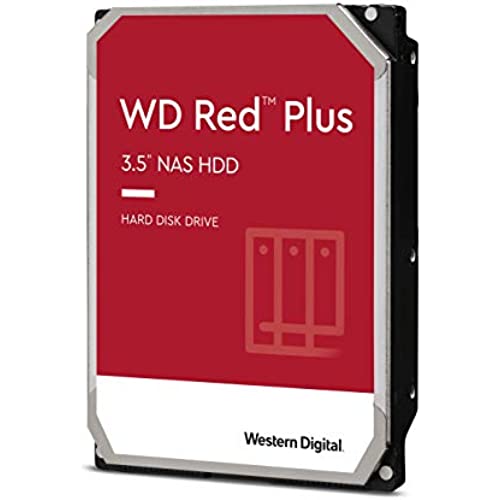
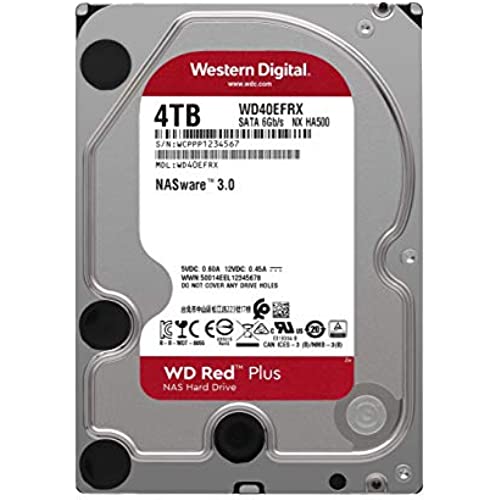
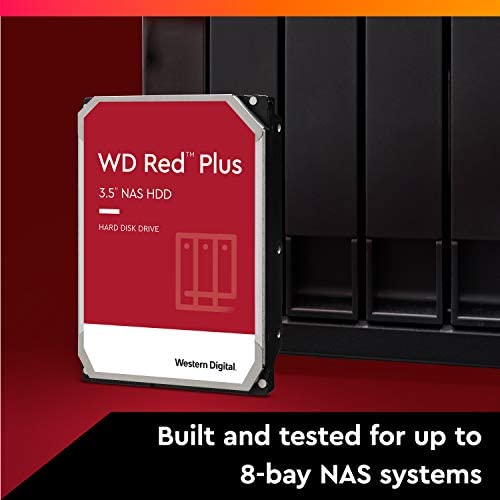
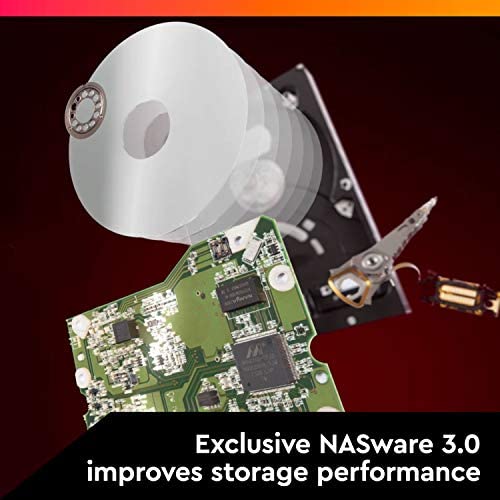

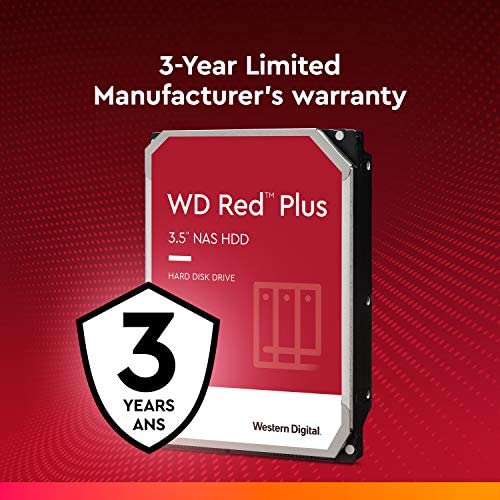
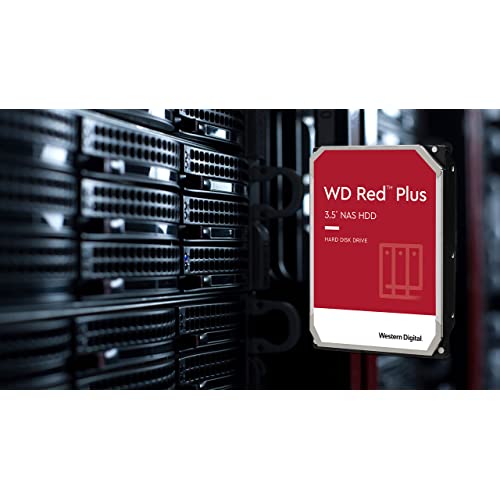







Western Digital 4TB WD Red Plus NAS Internal Hard Drive HDD - 5400 RPM, SATA 6 Gb/s, CMR, 64 MB Cache, 3.5 - WD40EFRX
-

somerandomguy
> 3 dayI have purchased 6 of these 4 TB WD Red drives for a Synology DS2413+ NAS. Installed the drives, partition and deep scan took about 12 hours for a single drive setup and about 20 hours for the same with a RAID 1. I dont require anything else yet as I have offline backups and not yet enough storage to mirror all of the drives online, I dont want any smaller drives on the NAS. I plan on setting up multiple RAID 1s as I add drives to this system. They are easy to build and rebuild if I have problems. All six drives are in a basement area at 68f and the drive temps are 72f-73f. The were 83f when scanning and formatting. The packaging was superb, each drive is in its own brown cardboard box with plastic ends to keep the drive from shifting and then was packed in a larger box. No errors or problems with these drives so far. I need six more before I can get all of my movies and music online, will take awhile to image all of my retail DVDs and CDs. The NAS and the memory for it were also packed well and are running well. Love Amazon for their free shipping as a prime member, this almost paid for the years worth. Update 12-Dec-13 So far the drives are running fairly cool and are very quiet, I have added 2 more of the 4TB models to my Synology DS2413 NAS. This did increase the temps slightly, they now hover around 83f when idle. Room temp is about 70f. The NAS has passive cooling on the board (though it does have an exhaust fan) so more drives adds more internal heat. They are pretty fast when transfering data (too lazy to run a speed test) over the network but it is more than fast enough to run multiple movie streams.
-

J. Kahn
> 3 dayI am a big fan of these WD Red NAS drives as I have several synology servers. Ive had pretty good luck with WD Black drives as those are extremely solid (and fast compared to these and the WD Greens), but these run significantly hotter which raises the overall temp of my NAS devices. The WD Green drives run cooler (and just about as fast as these WD Red drives), but are not good for NAS environments due to the TLER issue (they constantly spin up and down which adds needless wear and tear and will ultimately reduce the longevity of your drive). These arent the fastest drives out there, but they offer the perfect balance and are safe for use in NAS systems. I also had a lot of success with Samsung drives, but these were bought out by Seagate and, while I respect Seagates quality control, they are not comparible with SMART diagnostics, which is how synology units (and most diagnostic protocols) monitor the health of your drive. While my one seagate drive in operation has never failed me, I dont appreciate the fact that when and if it ever does, I will have zero warning. Therefore, I stick with WD drives so that I can monitor their health and replace them when and if they start developing bad sectors. Seagate seems to have done away with SMART compatibility so that end users could not diagnose the drives themselves. They probably got tired of people trying to RMA drives because of a single bad sector. So Seagate users are forced to use Seatools to examine their drives, which gives you only a passing (or failing grade) with no gray area in between (i.e. no hints that your drive is about to fail as long as it is still operating within what Seagate considers acceptable parameters). Its a shame too because my one Seagate drive is among the fastest I own and has worked solidly for 3+ years. I just dont completely trust it without the SMART data.
-

Denny
> 3 dayJust bought 2 drives advertised as Used: Like New | Details Sold by TechnoDealsUSA These drive pass all the S.M.A.R.T test but they have both be run for 48,000+ hours virtually non stop. That is over 5.5 years. I would not exactly call them Like New. I only saved about 20% buying used over new. I hope I dont regret this.
-

Darrel Dicki
07-06-2025WD40EFRX HDDs run very cool because they spin at 5400 RPM and have only 3 platters inside. They are CMR/conventional magnetic recording HDDs and NOT SMR/shingled magnetic recording HDDs. Most folks should avoid SMR HDDs like the plague because of the odd read before write cycle that SMR drives employ. If you need a 4 TB HDD the WD40EFRX is the perfect HDD as far as Im concerned because it is reliable and runs cool. Now, I dont need a 72000 RPM drive because I boot from an SSD. My 4 TB HDDs are strictly for long term storage. Heres some technical info about WD40EFRX HDDS from the HDD Platter Database: - ?early? WD40EFRX HDDs that have model #s like WD40EFRX-**WT0N* have 4 platters - modern WD40EFRX HDDs that have model #s like WD40EFRX-**N32N* have 3 platters When a drive spins fewer platters it generates less heat, thus less heat in your case.
-

Barry F. Hunt
> 3 dayI replace my NAS drives every couple of years or so as it gets full, doubling the capacity each time. Prior to these 8TB drives I had a pair of 4TB WD reds, and before that a pair of 2TB WD greens and before that a pair of 1TB WD greens. These drives perform very well - on a par with the 4s I removed. But they make lots of strange noises, like intermittent soft buzzing, and occasional faint humming. They are noticeably noisier than the 4TB reds I replaced. But Ive been running them for almost 2 months without a hiccup. I have yet to lose a WD drive in this NAS over 7 years of 24x7 operation so I will stick with WD until that changes.
-

T. Hole
> 3 dayOrdered 4 of these to make a RAID10 array to hold my iTunes, iPhoto and iMovie libraries. I had those libraries on a single Lacie external HDD via Thunderbolt and that failed right after the 3 year warranty expired. That wasnt catastrophic because I have multiple backups, but this gave me the excuse to use a RAID10 setup. I wanted the RAID10 for 2 reasons: 1. Ease of failure recovery 2. increased speed. Looked at a lot of drives and the WD Reds seemed to fit the bill. I also ordered an OWC Thunderbay 4 RAID Thunderbolt 2 enclosure to put them in. Nice combo. The speed of these drives seems right in line with what I expected. Heres what I measured with Blackmagic on my 2011 iMac through a TB cable: Single drive: 146 Mbps RAID0 x 4 drives: 560 Mbps (that was cool) RAID1 x 2 drives: 141 Mbps RAID10 x 4 drives: 286 Mbps That all seems to line up with expectations. There are probably faster single drives out there that push closer to 165+ Mbps, but this works for what I need. If I really want more speed Ill just put 4 SDDs in there and let er rip @ 1 Gbps. What made me giggle is that the internal drive on my iMac runs at 96 Mbps, so my external RAID10 is faster than the internal drive. I guess they made slower drives way back in 2011. Hope they hold up well but if they dont I wont have any down time.
-

Aaron
> 3 dayPurchased WD Red 4TB in 2016. I did not use it much for the first year or two. Early this year, I started using this drive a lot. I am using as an external drive in a USB 3.1 cradle for backups and short term storage of large (20GB to 100GB files). I appreciate the low vibration; other drives in the same cradle can cause resonate vibration of other things on my desk; this drive is almost silent and vibration free. I am getting all of the expected performance; no degradation from not having a direct SATA III connection. Operating temp is very good; it seldom gets above 40c, even after long periods of high activity. Other people have commented on warranty issues. While I have never had a problem with these drives, I did look up the warranty status on WDs website recently. They correctly reported that the warranty had just expired after my three years of ownership. In 2016, I paid about $150 for the 4TB model. I considered that a decent price. Earlier this year, I started looking for a new 4TB drive. At that time, this drive was about $115. I spent a week or two looking at refurb enterprise ;evel 4TB models. They go for about $80, and the quality and warranty are really hit or miss. Now, this drive in the 4TB size is down to $100. At that price, for exactly the same drive that I know and trust, it is hard to consider any other option than another WD Red 4TB. Make sure you purchase your drive from Amazon and not an Amazon market place seller. Check your warranty status as soon as you receive your drive and return it if WD does not recognize the full three years you are entitled to. If you compare price to size in the WD Red line, you will see that the 4TB size is by far the most economical. I am going to buy a second drive for general use. If the current pricing holds, I am going to buy six more of these to replace all of the drives in my ZFS system over the next year.
-

Scott Pederson
> 3 dayAlways looking for extra space? Yeah, me too. I had purchased an HP-MicroNAS server online, 8GB RAM but no HDs. So I added a pair of these 4TB RED disks. When they arrived, it was probably the fastest setup Id ever done. I utilized FreeNAS 11.2 (installed from a Thumb-drive) and a 750GB disk I had sitting around. The 750g was the system drive, and FreeNAS chose these two 4TB as a simple RAID1 Volume. The entire setup took about 10 minutes. Power - the whole unit uses less than 15-20w when idle, and scales up when needed. After replicating my data to this system, the drives were still inaudible, and the fan on the HP is whisper quiet too. Performance? Not the worlds fastest (at work I deal with close to 1GByte per second) but for daily archiving and storage, these are doing nicely on my 1gb LAN. Using LZ4 compression, they are doing nicely holding all of my photos and music. Additionally, my daughter is an artist and has LOTS of movie-editing files in her directory. Well see how it goes in 6mos, 1 year, 3 years. but by that time, Ill probably be using 20TB M.2 SSDs because they are $49. ;-) Bottom line, great performance and reliability for a good price.
-

MandM87
> 3 dayUpdate 1/24/14 - WD has posted a utility (WD Red SMART load/Unload utility)on the support download page for this drive that supposedly installs a firmware update to help with this problem. I have not tried it but it appears to be specifically designed for these drives and their high head parking issue. Update 1/11/14 - Just received and tested my 2nd drive from Amazon. It also was received with the Idle3 timer set to 8 seconds. I used the Wdidle3 program from WD to reset this timer to 300 seconds and then tested the drive using the WD Diagnostics Utility. Drive tested fine. For reference, both of these drives that came with the Idle3 timer set for 8 seconds were WD part number: WD30EFRX-68EUZN0. I have seen some indication on other web sites that this issue may be unique to drives with the -68EUZN0 part number. ========= My issue is a brand new WD30EFRX from Amazon that out of the box has the Idle3 timer set to 8 seconds. When installed in my ReadyNAS Ultra 4 it climbed to 1200 LCCs in the 1st 24 hours. Since the unit is only rated for 600,000 LCCs in its lifetime at this rate it would reach its specified rating in a little over a year. Based on the responses from WD below, I am forced to modify these drives using the WDIDDLE3 tool prior to installation in my NAS to give them any chance of lasting for the full 3-year warranty period. I have had a couple of email exchanges with WD Technical Support on this, the latest being today. I asked them 3 questions and have posted their responses below. Questions to WD Technical Support and their replies below 1. Is there something wrong with this drive? At the current rate of head parking this drive will reach a count of somewhere in the 2-3 million cycles before the 3 year warranty period is reached. If WD really believes that the drives can survive this many parking cycles why do you only list 600,000 in your specification? Since this will be 4-5 times the specified value it does appear something is wrong with the drive. (WD Response) Some utilities, operating systems, and applications, such as some implementations of Linux, for example, are not optimized for low power storage devices and can cause our drives to wake up at a higher rate than normal. This effectively negates the power-saving advantages of low-power drives, such as Western Digitals WD Red, and artificially increases the number of load-unload cycles. They also stated in another email that To date, we have had no reported hard drive failures due to cycle and load times with any of our drives. 2. Should the Idle3 timer have been set to 8 seconds when I received it? I have seen several other postings and test data/reviews on the internet where people state when they received their WD30EFRX the Idle3 timer was disabled? (WD Response) - They did not answer this question 3. Is there something I can do to reduce the LCC concern and increase the life of this drive if I am still concerned about it? I have seen several posts where people claim that using the WDIDLE3 tool works OK, but it is not listed as a drive for this tool on the WD web site. Is this tool OK to use or is there something else that can be done to change this operation? (WD Response) - The WDIddle3 utility has not been designed for this particular product. However, weve seen cases where customers have used the tool with this internal drive and managed to set Idle3 to max time which effectively turns off load/unload power saving feature. Please also find the link for the WDiddle3 utility which should allow you to set the WDiddle 3 for your needs. [...] Note that this is version 1_05. I have seen references to a version 2.0...., but have never been able to find a copy of it. The link they sent me is for version 1_05 and it worked fine for me. I have used the WDIDDLE3 (version 1_05) tool to set the Idle3 timer on my WD30EFRX to 300 seconds and so far I have only had a couple of LCC increases in a few days. Although this is a pain to deal with, I still believe this is a good drive for the NAS application and have another drive on order. It will be interesting to see if it also has the Idle3 timer set to 8 seconds when I receive it. If it does I will also change it to 300 seconds.
-

Cory in AZ
> 3 dayI purchased several of these hard drives to populate a NAS. I have been using Western Digital drives for decades and they have always been reliable and affordable. For my project, I under-estimated my drive requirements because I completely forgot about the dishonest business practice of drive manufactures counting 1000KB = 1MB. In real life, 1024KB = 1MB. The end result is that the consumer loses space and the manufacturer gets to advertise a larger capacity than what the hard drive can actually deliver. In a 4-bay NAS using 8TB drives, basic math says 4 drives x 8TB = 32TB of storage. In reality, you only get 29TB (4x7.25), which is a significant loss of 3TB over what the manufacturer advertises! Grrr!
